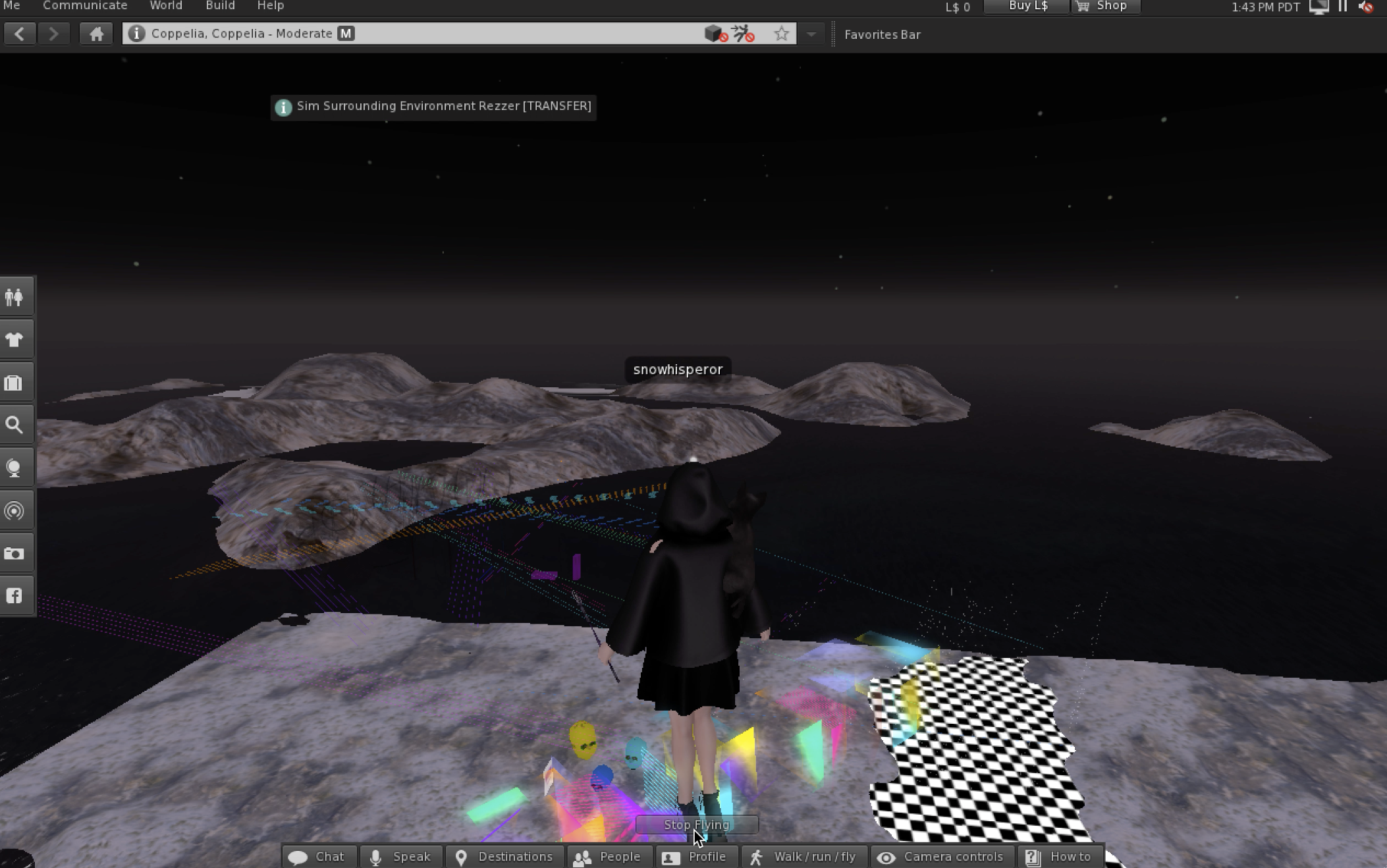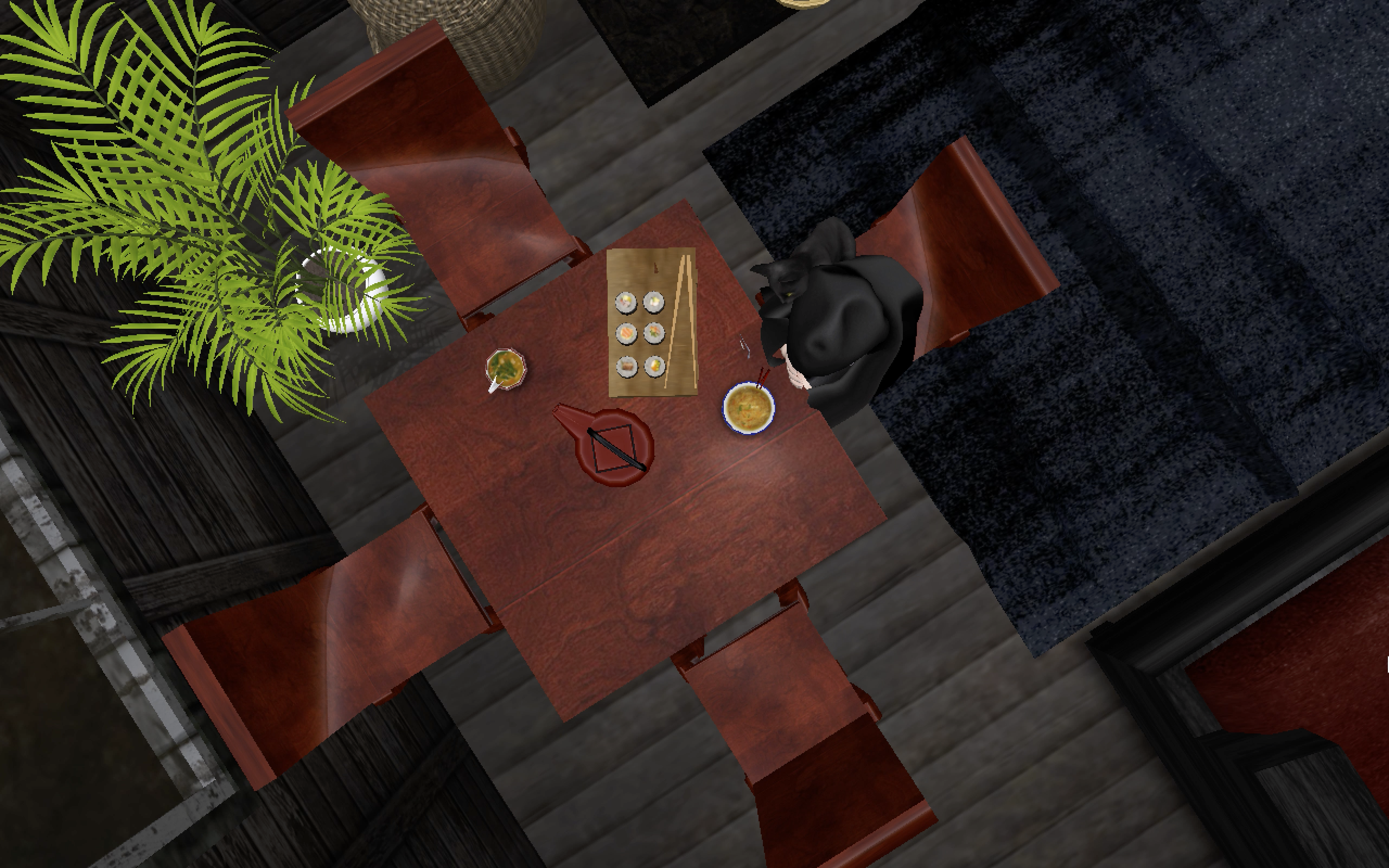Laws of the Virtual World
Before I started making the machinima, I knew I must learn the laws of the game world. I first explored the virtual social world of Second Life because it was the first virtual world platform introduced to me which in turn introduced me to machinima, and because it was a socializing space rather than a game space, which would require me to learn how the game works separate from the actual game world. Furthermore, Second Life is an online virtual world (founded in 2003), so it was readily accessible to me, and I downloaded the app for free. Because the game was free to play, considering I didn’t need any add-ons for my character or money for accessories, I was good to go. My situation fits exactly with how Lowood described: I would tend to choose the more accessible and cheaper platform. Given time constraints and non-professionalism in gaming, I decided to work with Second Life. In a sense, I’ve undermined the significance of the virtual space as a fascinating technological achievement, and have merely chosen to use the space for cinematic production, which Lowood describes:
The game engine lost its value as replay engine and remained only a production tool.
Because I am new to gaming in general, and while Second Life is indeed more of a social space than a game, its machine quality still makes me feel like I am playing a video game as I traverse its landscapes. Thus, I retained my curiosity in the game world by my unfamiliarity with digital, virtual spaces. This machinima project production has opened my eyes to new perspectives of acting in and seeing our real world, which I would not be able to conjure in film production in the real world setting.
My first step was virtual world exploration. I spent hours visiting different spaces and explored to nearly 20 locations. Many of the spaces actually did not have many players, and because I didn’t want to spend too much time learning all of the special moves or tricks in the game, I stuck to just one main character, myself, who I called snowhisperor. Our relationship was really weird, because I was she, but she was my puppet, and I was the puppeteer controlling her every move.

One of the earlier spaces I explored. This is an example of what the server interface looks like. I still couldn’t understand how I started flying, and how I could land.
I didn’t understand why there were so many random objects here and there. I started clicking on items, and descriptions came up. The information detailed which player created the item, and some had costs attached to them. Other items you can sit on. I was particularly freaked out by the creature below, because I didn’t know if it was a player or a creation by a player. It turned out it was a creation by a player, and it seemed to like me very much, and I it.

I was actually going to use this shot in the film but I realized my cursor was accidentally in the shot, and because the footage was capture via screen capturing, I couldn’t alter the image in post-production. I would have needed photoshop, which is an extra step I didn’t have time to take.
As I continued exploring spaces, I realized that I could click a button on land and teleport elsewhere, most likely into a space suspended in mid air. Below was one of my most favorite teleportation sites.
The Mechanical Human Body
My second step was to learn how to move my character’s body. This process slowly took shape as I was exploring spaces. As I clicked on random items, I realized that I could choose the option “Sit,” and by magical computer programming, I would be able to sit on the item. In the case below, when I sat on the panda car, it started running in circles on its own accord, and specifically coded me to sit in that particular manner. This was a set digital code that I couldn’t break, or at least, didn’t know how to break.
I wanted to know how I could give my character facial expressions. After searching online, I learned that I could only apply very brief facial expression by clicking on, say “Laugh” in a drop-down menu, but that would mean I needed to have my interface on, and I could have that in screen capture. After exploring more places, I realized that certain items in which you could sit on programmed for the character sitting to perform certain facial expressions or action. (I am careful in not saying they program emotions, because emotions are felt, while facial expression suggest an emotion that we would often relate to that facial expression.)
Some examples include “M1” or “F3” which represents “Male sitting style #1” and “Female sitting style #3,” so I would try out the different sitting styles to find the one that most suites the currently situation I would like my character to be in for the film. I thought it was interesting that these options had gender attached to them, as if our everyday moves may be categorized under stereotypical gendered qualities. For the action below, I chose to have my character appear frustrated, given that the chair I was sitting on programmed such an option for me to use.
For all of the “emotions,” I performed via pre-programmed actions when I had to sit on an item. Once, when I was sitting on the bed in the beach house, there were options in which I could choose to hold certain objects as I was sitting on the bed, such as coffee, paper, or a laptop, while simultaneously performing the respective actions in relationship with each object. Every time I tried holding a new object, the interface gave me a statistical value describing how “upgraded” my character’s body is. Thus, I assumed that I would only be able to perform more moves and facial expressions if I played the game long enough. Unfortunately, I was on a time budget, so many of the shots you only see my character walking, flying, or sitting. Dancing was out of the picture.
In this sense, I am strictly limited in what I could do, and in turn, perform. This limitation, although present in the virtual world, would not happen in the real world, when we may simply perform the act without needing special time commitments and code to obtain the action. As Ian Jones states in Enough of a World, “machinima is always inescapably ‘shaped by, and bears marks and traces of, its host game world.'”
Visceral Quality and Perceptual Consciousness
So after I learned how to move through virtual spaces, I started to gain a virtual consciousness. I started to gain motor control in how my character walked and flew. I knew that in order to enter a room with a door, I must first click on the door and then the door would open. The laws of the world were slowly closing in around me, until everything I did within the world came naturally, or nearly so. This is when the image grew in significance. I started to pick up the intricacies of every object. In the image below, I was in Kowloon Town just looking around. I came into this restaurant thinking the people there were actual players, but they were not—I was still alone. I watched the television for a little while; it was in Japanese. I looked at the posters on the wall; they were extremely detailed. Some of the posters stated which players were residents on the upper floors. I was truly fascinated with the details.
I sat down on this round table, and started clicking on the object with the wooden barrel. It turned out it was literally a game, and as I plugged in plastic knives, notices came up that I was defeating someone, even though no one was playing with me. It was a little scary, and not very productive for filming, but it did increase my virtual consciousness and feeling through action in a virtual world. In fact, there were many times when I was merely watching around in the virtual space, looking here and there, and not actually filming anything. I knew that was the moment when my consciousness left my real body and entered the screen through my character. I often had to snap back and get back to reality.
Lastly, after learning and familiarizing myself with the virtual world, I found an excessive amount of advertisements, considerably all real, in the sense that some advertisements were for buying items in Second Life, others were for donating money for real life events. The boundary between real and fake was really blurry, and so I didn’t meddle with the economical side of the world.

I really liked this logo-statue. I thought it would come to use as representative of the relationship I wanted to establish between the character and the “you” she is referring to. However, this logo is also very ironic because it is often the catch-phrase for companies to get customers to learn more about them. Along with the bill board in the back, that’s when I got the sense that the world I was in was commercially substantiated, and wasn’t simply there to exist.
Although Henry Lowood states in The Machinima Reader that machinima is “cut off from its previous dependence on game technology in postproduction and distribution” and that “the game world provided only the production environment,” my situation claims this statement invalid in the sense that I did need the game technology to give my character the movements and emotions that I wanted to carry forth in the film, even if on such a minuscule scale.
Overall, these are my thoughts on how machinima works as a machine.




